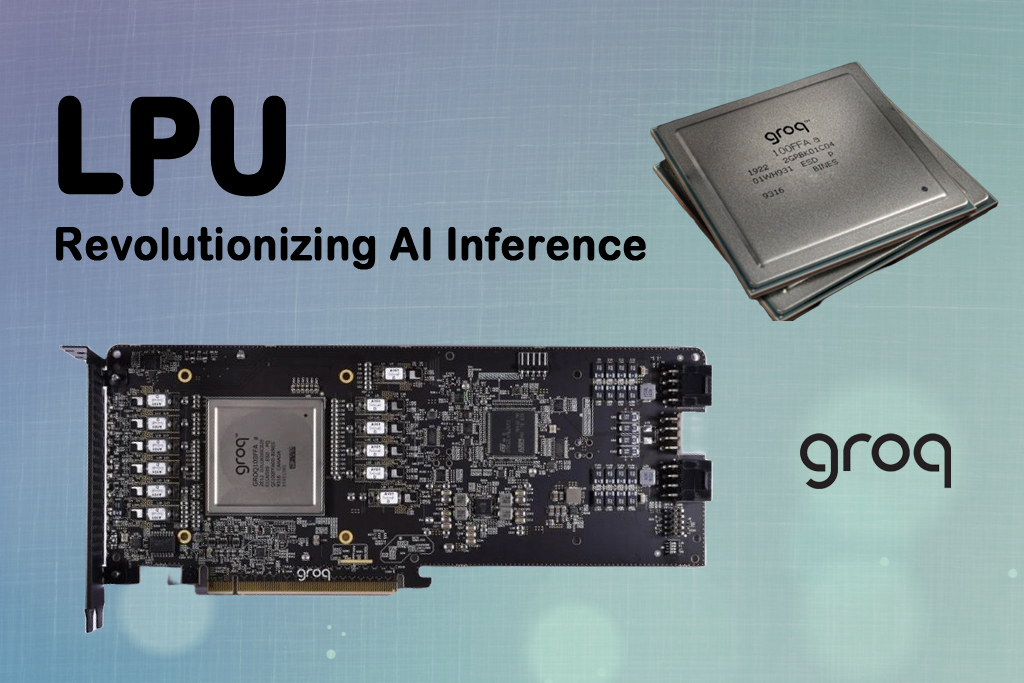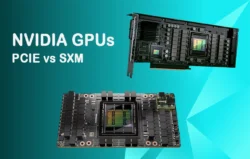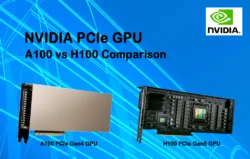Key Points
- Groq’s LPU: A specialized chip designed for AI inference, offering faster speeds and lower energy use than Nvidia GPUs for tasks like running large language models (LLMs).
- Impact on Nvidia Users: Likely attracting users focused on real-time AI applications due to its speed and efficiency, though Nvidia GPUs remain preferred for training and versatile workloads.
- Benefits: High inference speed (500-750 tokens/second), low latency (~0.2 seconds), energy efficiency (1-3 joules/token), and cost-effective operation for inference tasks.
- Price and Performance: LPU cards cost ~$20,000, similar to high-end Nvidia GPUs, but excel in inference speed and efficiency, though limited to inference-only tasks.
- Manufacturing and Funding: Produced with Global Foundries, funded by BlackRock ($640M, 2024) and Saudi Arabia ($1.5B, 2025), with a valuation of $2.8B.
- Users and Applications: Used by companies like Dropbox and Volkswagen for real-time AI tasks like chatbots, voice assistants, and autonomous systems.
Introduction
The artificial intelligence (AI) landscape is evolving at an unprecedented pace, with the demand for efficient hardware to power large language models (LLMs) driving innovation in chip design. Traditional Graphics Processing Units (GPUs), led by Nvidia’s dominant offerings, have been the backbone of AI training and inference. However, their general-purpose architecture can be less efficient for the specific demands of AI inference, where low latency and high throughput are critical for real-time applications like chatbots, voice assistants, and autonomous systems. Groq, a Silicon Valley startup founded in 2016 by former Google engineer Jonathan Ross, has introduced the Language Processing Unit (LPU), a chip tailored for AI inference. The LPU’s unique design promises to deliver superior speed and energy efficiency, positioning it as a compelling alternative to Nvidia’s GPUs in the rapidly growing inference market.
Groq’s rise has been bolstered by significant financial backing and strategic partnerships. In August 2024, the company raised $640 million in a Series D round, valuing it at $2.8 billion, followed by a $1.5 billion commitment from Saudi Arabia in 2025 to expand an AI data center in Dammam. Partnerships with industry giants like Meta, Bell Canada, and Equinix, along with a new data center in Helsinki, Finland, highlight Groq’s global ambitions. Independent benchmarks, such as those by ArtificialAnalysis.ai, have shown the LPU outperforming competitors, achieving up to 241 tokens per second for Llama 2 (70B). While Nvidia’s GPUs remain unmatched for training and broad workloads, Groq’s LPU is carving out a niche for inference, potentially reshaping how businesses deploy AI at scale.
What is the LPU?
The Language Processing Unit (LPU), initially known as the Tensor Streaming Processor (TSP), is a single-core chip designed by Groq to accelerate AI inference, particularly for LLMs like Llama, Mistral, and Mixtral. Unlike GPUs, which excel in parallel processing for tasks like graphics rendering and AI training, the LPU is optimized for the sequential processing required by language models, where each token depends on the previous one. Its architecture integrates memory and compute units, using a software-first approach where the compiler defines hardware operations, ensuring deterministic performance without the overhead of dynamic scheduling.
Key technical specifications include:
- Compute Power: 750 Tera Operations Per Second (TOPS) at INT8 and 188 TeraFLOPS at FP16, with 320×320 fused dot product matrix multiplication and 5,120 Vector ALUs.
- Memory: 230 MB of on-chip SRAM per chip, delivering 80 TB/s bandwidth, which minimizes external memory access and reduces power consumption.
- Architecture: A functionally sliced microarchitecture with massive parallelism, eliminating non-determinism (e.g., memory hierarchy, interrupts) for predictable performance.
This design makes the LPU ideal for real-time applications like autonomous vehicles, robotics, and advanced chatbots, where low latency and high throughput are essential.
Influence on Nvidia Users
Nvidia’s GPUs, such as the A100 and H100, dominate the AI chip market with an estimated 80-95% share, driven by their versatility and the robust CUDA software ecosystem. However, Groq’s LPU is influencing Nvidia users, particularly those prioritizing inference over training. The LPU’s ability to process LLMs at 500-750 tokens per second—compared to 10-30 tokens per second for Nvidia GPUs—offers a significant advantage for applications requiring rapid responses, such as customer service chatbots or gaming AI. For example, benchmarks show the LPU running Llama 2 (70B) at 241-300 tokens per second, far surpassing GPU-based solutions.
The LPU’s energy efficiency, consuming 1-3 joules per token versus 10-30 joules for GPUs, appeals to businesses scaling inference workloads, where operational costs are a concern. This is particularly relevant for edge AI deployments, such as in autonomous vehicles or IoT devices, where power constraints are critical. Additionally, the LPU’s deterministic performance ensures consistent latency, unlike GPU clusters, which can experience variability due to scheduling complexities.
However, Nvidia’s GPUs remain the preferred choice for users needing hardware for both training and inference or diverse workloads like computer vision and scientific computing. The CUDA platform’s maturity and developer support further solidify Nvidia’s position. While LPUs are not poised to replace GPUs entirely, they are likely attracting users focused on real-time inference, potentially eroding Nvidia’s dominance in this niche.
Benefits of the LPU
The LPU’s design offers several compelling advantages for AI inference:
- Unmatched Speed and Low Latency:
- Achieves 500-750 tokens per second for models like Llama 3 (70B), compared to 10-30 tokens per second for GPUs.
- Time to first token is ~0.2 seconds, enabling seamless real-time interactions for applications like voice assistants and chatbots.
- Energy Efficiency:
- On-chip SRAM (230 MB, 80 TB/s bandwidth) minimizes data movement, reducing power consumption to 1-3 joules per token, up to 10x more efficient than GPUs.
- Cost Efficiency:
- LPU cards cost ~$20,000, but their high throughput and low energy use reduce the cost per token, offering long-term savings for large-scale inference.
- Deterministic Performance:
- The “assembly line” architecture, driven by a kernel-less compiler, ensures predictable performance, eliminating variability seen in GPU clusters.
- Scalability:
- Scales linearly with sub-millisecond latency (1.6µs per GroqRack), ideal for large-scale deployments without GPU-like bottlenecks.
- Ease of Integration:
- Supports standard ML frameworks (PyTorch, TensorFlow, ONNX), allowing developers to integrate LPUs with minimal code changes.
These benefits make the LPU a game-changer for applications requiring rapid, energy-efficient inference, from consumer-facing AI to enterprise data processing.
Price and Performance Comparison to Nvidia GPUs
The following table compares Groq’s LPU and Nvidia’s GPUs across key metrics:
| Metric | Groq LPU | Nvidia GPU (e.g., A100) |
|---|---|---|
| Price | ~$20,000 per card | $10,000-$15,000 (A100), $30,000-$40,000 (H100) |
| Inference Speed | 500-750 tokens/s (Llama 3 70B) | 10-30 tokens/s (Llama 3 70B) |
| Latency | ~0.2s (time to first token) | Higher, variable latency |
| Energy Consumption | 1-3 joules/token | 10-30 joules/token |
| Memory | 230 MB SRAM/chip, 14 GB/rack | 80 GB HBM2e (A100) |
| Compute Power | 750 TOPS (INT8), 188 TeraFLOPS (FP16) | 312 TFLOPS (FP16) |
| Use Case | Inference only | Training and inference |
- Pricing: LPU cards are priced similarly to high-end Nvidia GPUs, but their operational efficiency (lower energy and higher throughput) reduces long-term costs.
- Performance: LPUs significantly outperform GPUs in inference speed and latency, with benchmarks showing up to 18x faster throughput for Llama 2 (70B). However, their memory capacity (14 GB/rack) limits their use for larger models like Llama 3.1 (405B), where GPUs’ 80 GB HBM is advantageous.
- Use Cases: LPUs are specialized for inference, while GPUs are versatile for both training and inference, making them suitable for broader AI and non-AI workloads.
Manufacturing and Funding
Groq, based in Mountain View, California, designs its LPUs and collaborates with Global Foundries for production, leveraging a resilient supply chain. The company plans to scale to 1 million LPUs by 2025, supported by significant funding:
- August 2024: $640 million Series D round led by BlackRock, valuing Groq at $2.8 billion.
- 2025: $1.5 billion commitment from Saudi Arabia for an AI data center in Dammam.
- Additional investors include Samsung Electronics, Cisco Investments, and Social Capital.
- Groq is seeking $600 million more at a $6 billion valuation.
Strategic partnerships with Meta, Bell Canada, and Equinix (including a Helsinki data center) enhance Groq’s global presence and credibility.
Users and Purposes
Groq’s LPU serves a diverse user base:
- Developers and Startups: Over 1.9 million developers use GroqCloud, which offers a free tier for experimentation.
- Enterprises: Companies like Dropbox (AI-driven features), Volkswagen (autonomous driving), and Riot Games (gaming AI) leverage LPUs.
- Government Projects: Saudi Arabia’s $1.5 billion investment supports large-scale AI infrastructure.
Applications include:
- Real-Time AI Inference: Chatbots, voice assistants, and generative AI.
- Edge AI: Autonomous vehicles, robotics, and IoT devices.
- Large-Scale Data Processing: Efficient handling of vast datasets.
Groq’s deployment options—GroqCloud and GroqRack—cater to both cloud and on-prem needs.
Critical Perspective
While Groq’s claims of 10x-100x faster inference are impressive, they lack peer-reviewed benchmarks like MLPerf for full validation. Nvidia’s dominance stems from its mature ecosystem, production scale, and versatility, which LPUs cannot yet match. The LPU’s focus on inference and smaller models (e.g., 70B parameters) is a smart niche, but scaling to larger models or multi-node clusters may pose challenges. Partnerships with major players like OpenAI or xAI could boost Groq’s credibility, but these remain speculative.
Conclusion
Groq’s LPU is a transformative force in AI inference, offering unmatched speed, energy efficiency, and cost-effectiveness for LLMs. While Nvidia’s GPUs remain dominant for training and versatile workloads, LPUs are carving out a significant niche for real-time inference applications. With robust funding, strategic partnerships, and growing adoption, Groq is poised to challenge the status quo in the AI hardware market. Developers and enterprises can explore LPU capabilities at groq.com.
FAQs about Groq’s LPU
1. How does Groq’s LPU compare to other AI inference chips, not just Nvidia’s GPUs?
Groq’s LPU is specifically designed for AI inference, particularly for large language models (LLMs), and offers superior speed and energy efficiency compared to traditional GPUs. While Nvidia dominates the AI chip market with its GPUs, other companies like AMD, Intel, and startups such as Cerebras Systems and SambaNova Systems are also developing AI chips. However, Groq’s LPU stands out due to its specialized architecture for inference, achieving up to 500-750 tokens per second for LLMs, significantly higher than the 10-30 tokens per second of Nvidia GPUs. Additionally, Groq’s LPU uses on-chip SRAM, which provides up to 10x better energy efficiency than GPUs, making it a unique contender in the inference market.
2. What are the specific use cases where Groq’s LPU is superior to Nvidia’s GPUs?
Groq’s LPU excels in real-time AI applications that require low latency and high throughput, such as chatbots, voice assistants, and other generative AI tasks. Its ability to process LLMs at 500-750 tokens per second, compared to 10-30 tokens per second for Nvidia GPUs, makes it ideal for applications where instant responses are critical. Additionally, the LPU’s energy efficiency (1-3 joules per token vs. 10-30 joules for GPUs) makes it particularly suitable for edge AI deployments, such as autonomous vehicles or IoT devices, where power constraints are significant.
3. How does the pricing model of Groq’s LPU compare to Nvidia’s GPUs in terms of total cost of ownership?
While the upfront cost of Groq’s LPU cards is around $20,000, similar to high-end Nvidia GPUs like the A100 or H100, the total cost of ownership is lower due to the LPU’s higher throughput and lower energy consumption. The LPU’s ability to process more tokens per second and its energy efficiency (1-3 joules per token) result in a lower cost per token, making it more cost-effective for large-scale inference workloads over time. This operational efficiency can lead to significant savings for businesses prioritizing inference tasks.
4. What is the current market share of Groq in the AI inference market?
Although exact market share figures are not readily available, Nvidia dominates the overall AI chip market with an estimated 80-95% share, driven by its GPUs’ versatility for both training and inference. Groq, being a relatively new player, focuses specifically on inference and has not disclosed its market share. However, its growing partnerships (e.g., with Meta, Bell Canada, and Saudi Arabia) and significant funding (e.g., $640 million in 2024 and $1.5 billion in 2025) indicate increasing traction in the inference niche.
5. Are there any known limitations or challenges with using Groq’s LPU that users should be aware of?
One key limitation of Groq’s LPU is that it is designed only for inference and not for training, which may limit its appeal for users who need hardware for both tasks. Additionally, the LPU has limited memory capacity (14 GB per rack), which might be restrictive for very large models like Llama 3.1 (405B). While the LPU’s software ecosystem is growing, it is still newer compared to Nvidia’s mature CUDA platform, which has a larger developer community and more established support.
6. How does Groq’s LPU handle different types of AI models, such as computer vision models or recommendation systems?
While Groq’s LPU is primarily optimized for LLMs, it can handle other types of AI models, such as computer vision models or recommendation systems. However, its performance may not be as optimized for these tasks as it is for language models. The LPU’s architecture is tailored for sequential processing, which is ideal for LLMs but may not fully leverage the parallel processing capabilities required for some computer vision or recommendation tasks.
7. What is the development and support ecosystem like for Groq’s LPU compared to Nvidia’s CUDA?
Nvidia’s CUDA platform is mature and widely adopted, with a large community of developers and extensive resources. In contrast, Groq’s ecosystem is newer but supports standard machine learning frameworks like PyTorch, TensorFlow, and ONNX, making it accessible for developers. However, Groq’s software stack may lack the same level of developer support and maturity as Nvidia’s, which could be a consideration for users prioritizing ease of development and integration.
8. How does Groq’s LPU perform in terms of scalability for very large deployments?
Groq’s LPU is designed to scale linearly with sub-millisecond latency (1.6µs per GroqRack), making it suitable for large-scale deployments. Its “assembly line” architecture ensures consistent performance across nodes, unlike GPU clusters that may experience variability due to scheduling complexities. However, the LPU’s memory constraints (14 GB per rack) might pose challenges for very large models or multi-node clusters, though it remains highly scalable for inference workloads.
9. What are the energy efficiency benefits of Groq’s LPU in real-world applications?
Groq’s LPU offers significant energy efficiency benefits due to its on-chip SRAM (230 MB per chip, 80 TB/s bandwidth), which minimizes data movement and reduces power consumption. It consumes 1-3 joules per token, compared to 10-30 joules for GPUs, making it up to 10x more energy-efficient. This is particularly advantageous for real-world applications in edge AI, such as autonomous vehicles or IoT devices, as well as for large-scale data centers where energy costs are a concern.
10. How does Groq’s LPU integrate with existing cloud infrastructure and services?
Groq provides both cloud (GroqCloud) and on-prem (GroqRack) solutions, allowing users to integrate the LPU into their existing infrastructure. GroqCloud offers a full-stack platform for fast, affordable, production-ready inference, while GroqRack compute clusters are ideal for enterprises needing on-prem solutions. The LPU supports standard ML frameworks like PyTorch, TensorFlow, and ONNX, facilitating easier deployment and integration with existing







